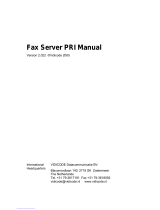
Mediant 2000 SIP
Mediant 2000 SIP User’s Manual 4 Document #: LTRT-72504
5.8.3.2 Numbering Plans and Type of Number ...................................................................................... 48
5.8.4 Configuring the Routing Tables...........................................................................................49
5.8.4.1 Tel to IP Routing Table .............................................................................................................. 49
5.8.4.2 IP to Trunk Group Routing Table ............................................................................................... 51
5.8.4.3 Internal DNS Table..................................................................................................................... 53
5.8.4.4 Reasons for Alternative Routing.................................................................................................54
5.8.5 Configuring the Profile Definitions.......................................................................................55
5.8.5.1 Coder Group Settings ................................................................................................................ 55
5.8.5.2 Tel Profile Settings ..................................................................................................................... 56
5.8.5.3 IP Profile Settings....................................................................................................................... 57
5.8.6 Configuring the Trunk Group Table.....................................................................................58
5.8.7 Configuring the Trunk Group Settings.................................................................................60
5.9 Advanced Configuration .................................................................................................................62
5.9.1 Configuring the Network Settings........................................................................................62
5.9.1.1 Configuring the SNMP Managers Table..................................................................................... 63
5.9.1.2 Multiple Routers Support............................................................................................................ 63
5.9.1.3 Simple Network Time Protocol Support ..................................................................................... 63
5.9.2 Configuring the Channel Settings........................................................................................65
5.9.3 Configuring the Trunk Settings............................................................................................66
5.9.4 Configuring the TDM Bus Settings......................................................................................68
5.9.5 Restoring and Backing up the Gateway Configuration .......................................................69
5.9.6 Regional Settings ................................................................................................................70
5.9.7 Changing the Mediant 2000 Username and Password ......................................................71
5.10 Status & Diagnostic ........................................................................................................................71
5.10.1 Gateway Statistics...............................................................................................................71
5.10.1.1 IP Connectivity ........................................................................................................................... 71
5.10.1.2 Call Counters ............................................................................................................................. 73
5.10.2 Monitoring the Mediant 2000 Trunks & Channels...............................................................75
5.10.3 Activating the Internal Syslog Viewer..................................................................................76
5.10.4 System Information .............................................................................................................77
5.11 Software Update Menu...................................................................................................................78
5.11.1 Software Upgrade Wizard ...................................................................................................78
5.11.2 Auxiliary Files ......................................................................................................................82
5.11.3 Updating the Software Upgrade Key...................................................................................83
5.12 Save Configuration .........................................................................................................................84
5.13 Resetting the Mediant 2000............................................................................................................85
6 ini File Configuration of the Mediant 2000...............................................................87
6.1 Secured ini File ...............................................................................................................................87
6.2 Modifying an ini File........................................................................................................................87
6.3 The ini File Content.........................................................................................................................88
6.4 The ini File Structure.......................................................................................................................88
6.4.1 The ini File Structure Rules .................................................................................................88
6.5 The ini File Example .......................................................................................................................89
6.6 Basic, Logging, Web and RADIUS Parameters .............................................................................90
6.7 SNMP Parameters..........................................................................................................................98
6.8 SIP Configuration Parameters......................................................................................................100
6.9 ISDN and CAS Interworking-Related Parameters........................................................................111
6.10 Number Manipulation and Routing Parameters ...........................................................................115
6.11 E1/T1 Configuration Parameters..................................................................................................122
6.12 Channel Parameters.....................................................................................................................128
6.12.1 Dynamic Jitter Buffer Operation ........................................................................................132
6.13 Configuration Files Parameters ....................................................................................................133
7 Configuration Files..................................................................................................135
7.1 Configuring the Call Progress Tones............................................................................................135
7.1.1 Format of the Call Progress Tones Section in the ini File.................................................135
7.2 Prerecorded Tones (PRT) File......................................................................................................137
7.2.1 PRT File Format ................................................................................................................137
7.3 Voice Prompts File........................................................................................................................137
7.4 CAS Protocol Configuration Files .................................................................................................138
8 Gateway Capabilities Description ..........................................................................139
8.1 Proxy or Registrar Registration Example .....................................................................................139
8.2 Redirect Number and Calling Name (Display)..............................................................................139
8.3 ISDN Overlap Dialing....................................................................................................................140





















